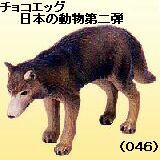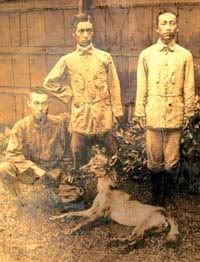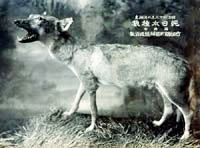|
|
Post by Wolvesmaster on May 10, 2005 18:17:23 GMT
What we know about the Japanese Wolf, canis lupus hodophilax?
what eat it and what this truelly a subspecies or a distinct species calles canis hodophilax?
|
|
|
|
Post by sebbe67 on May 10, 2005 18:20:16 GMT
Japanese wolfWolf or dog? The first important zoological and botanical collections from Japan were brought together by the famous collector Philipp Franz von Siebold and his assistant Heinrich Bürger during the period 1824-1834. Von Sieboldand Bürger,both Germans, were employed by the Dutch government and were based on the Dutch trade post of Dejima near Nagasaki. Though virtually confined to this tiny artificial island, Von Siebold, as a teacher of medicine to Japanese students, established many contacts and through these acquired specimens from all over Japan.  Japanese wolf His collections were sent to Leiden, where many new species were described on the basis of this material. Among the zoological specimens was a dog-like animal, which was regarded a wild wolf, though it was much smaller than its Eurasian counterpart. In 1839 the director of the National Museum of Natural History, C.J. Temminck, described this ' wolf' as a separate species, Canis hodophilax Temminck, 1839. In 1843 the animal was pictured in the Fauna Japonica, the first comprehensive work (though unfinished) on the animal world of Japan. Apart from the mounted skin, Temminck also had one skeleton and two skulls from the Von Siebold/Bürger collection.  Japanese wolf Photograph by Rosamond Purcell from Swift as a Shadow. © 1999. No longer a wolf For a long time, the mounted specimen in Leiden was already considered 'likely to be a feral domestic dog' because of its small size. Nowadays the Japanese wolf is considered a mere subspecies of the Eurasian/American wolf. Two subspecies of Canis lupus are generally recognized for the Japanese archipelago: the larger, northern form Canis lupus hattai of the island of Hokkaido, and the smaller Canis lupus hodophilax of the island of Honshu. These forms probably represent two independent invasions of wolves into Japan during different stages of the Ice Age, Canis lupus hodophilax being the older population differing most notably from the mainland wolves.  Japanese wolf Photograph by Rosamond Purcell from Swift as a Shadow. © 1999. Sacred animal The Japanese wolves lived in wooded and mountainous regions. Although elsewhere in the world wolves have been heavily persecuted, this has never occurred to the same extent in Japan. Here, the wolf was revered as a sacred animal, which protected the crops against damage by deer. It is not known what has led to the extinction of the Japanese populations. The last animal in Hokkaido was found in 1890, the last wolf in Honshu was killed for a British expedition on 23 January 1905, near the village of Washikaguchi, Nara Prefecture. The museum collection There is considerable doubt regarding the nature of the mounted specimens in the Leiden Museum. The animal, though adult, seems far too small even for a Japanese wolf, and its back is too dark-coloured. Moreover, its skull shows all the characteristics of domestic dogs. Von Siebold bought this animal from the local population and kept it in captivity for some time. Of Canis lupus hodophilax a skeleton and a skull are stored in the collection of the National Museum of Natural History. Written by Dr. L.W. van den Hoek Ostend. Source: www.naturalis.nl/300pearls/.
|
|
|
|
Post by sebbe67 on May 10, 2005 18:31:16 GMT
|
|
|
|
Post by another specialist on May 10, 2005 21:23:28 GMT
All the above information is available from here www.naturalis.nl/300pearls/click link on left saying extinct animals then click on link saying mammals then finally click on Japanese wolf - Wolf or dog? As previously trend is copy and pasted the images are missing and you may like to see them . |
|
|
|
Post by Peter on May 20, 2005 14:47:34 GMT
|
|
|
|
Post by another specialist on May 20, 2005 15:00:48 GMT
nice work looks good with images.....  |
|
|
|
Post by another specialist on May 22, 2005 19:09:00 GMT
|
|
|
|
Post by another specialist on Jun 14, 2005 15:39:56 GMT
|
|
|
|
Post by another specialist on Jun 14, 2005 15:42:18 GMT
The subspecies that the name 'Japanese Wolf' usually describes is the Honshu Wolf (Canis lupus hodophilax; ÈÕ±¾ÀÇ Nihon ¨kami), which occupied the islands of Honshu, Shikoku, and Kyushu in Japan. It is thought to have become extinct due to a combination of rabies, which first occurred in the islands in the 17th century, and human eradication. The last known specimen died in 1905, in Nara Prefecture. There are currently eight known pelts and five stuffed specimens of the Japanese Wolf in existence: one stuffed specimen is in the Netherlands, three are in Japan, and the animal caught in 1905 is kept in the British Museum. Owing to its small size (the Honshu Wolf is the smallest known variety of wolf, probably due to allopatric speciation / island dwarfing) the Honshu Wolf's classification as a subspecies of the grey wolf is disputed. www.biologydaily.com/biology/Japanese_Wolf |
|
|
|
Post by another specialist on Jun 14, 2005 15:46:26 GMT
On the Extinction of the Japanese Wolf please note this is on both subspecies of wolves that were known to live in Japan... www.wolfology.com/id147.htm |
|
|
|
Post by sebbe67 on Jul 27, 2005 22:21:16 GMT
|
|
|
|
Post by Melanie on Jul 27, 2005 22:41:31 GMT
pics found by sebbe   |
|
|
|
Post by another specialist on Jul 28, 2005 5:48:05 GMT
|
|
|
|
Post by another specialist on Jul 28, 2005 5:51:41 GMT
|
|
|
|
Post by Melanie on Aug 30, 2007 21:15:58 GMT
There now remains but one form to consider, which is the variety,
or species, named by Temminck Canis hodophilax, which he tells us is
called " Jamainu"
by the natives. It is said to inhabit woody and
mountainous parts of Japan, where it hunts in small troops or families,
and is greatly dreaded by the Japanese, who even consider its flesh
unwholesome to eat.
As to its specific distinctness, Temminck admits that it is very like
the Common Wolf, but asserts it to differ therefrom not only by its
smaller size, but also, and above all, by the shortness of its legs.
Nevertheless, we have seen undoubted specimens of C. lupus with legs
as short as those of the animal represented in Temminck's plate.
Prof. D. Brauns, however, considers the variety a distinct species,
and his figure, which we here reproduce (fig. 17, p. 14), does show
limbs which are relatively short, but the tail is hardly so, although he
makes its shortness a distinctive character as well as the greater
elongation of the muzzle. But he remarks :
" There can be no doubt
as to the existence of only one kind of wolf in Japan." In the British Museum, however, there are two skulls of wolves from
Japan. Neither skull exhibits any character by which it can be
specifically distinguished from C. lupus, but the two differ very much in size, though both are fully adult. If, then, so great a difference can
exist between the size of the head of adult Japanese wolves, it is
difficult to think that the length of the limbs may not have varied
from that found in the Continental wolves. Moreover, Prof. Brauns
lets us know that the Japanese variety (hodophylax) does vary much,
since he expressly says that in the Museum at Tokio there are very differently coloured skins, namely
"yellowish," "brownish," and
"whitish grey."
Of the two skulls in the British Museum, the larger one comes from
the province of Yesso a region which has Palaearctic affinities. The
small one is from the province of Kotsuke, which is more Oriental in
its zoological character. They may well therefore be nothing more
than local varieties, differently modified in harmony with their respectively
diverse environments. This quite agrees with what we find in
the American continent, where the difference of the lengths of the
skull of a number of North-Mexican and Hudson-Bay wolves amounts
to no less than twenty-five per cent, of the average size in the whole
series *.
Altogether, we cannot yet see our way to advancing the Japanese
variety to the rank of a species. Our view is in harmony with the
opinion expressed by Professor Huxley, who, when specially studying
the Canidae, had the advantage of seeing a living specimen of this form.
He says : "The Japanese C. hodophilax, of which there is a fine
specimen now living in the Gardens, appears to be simply a small form
of wolf ; but in the absence of any accessible skulls of this form, I
refrain from giving any definite opinion." Having ourselves now had
the opportunity of examining two skulls, we are in a position to confirm
the provisional opinion above quoted, based on the inspection of a
living specimen.
Source: Dogs, Jackals, Wolves and Foxes. Monograph of the Canidae. St. George Mivart
|
|
|
|
Post by temujin on Aug 31, 2007 14:37:14 GMT
That wolf became heavely persecuted in Japan after 1868,as the Meiji government promoted ranching in western-style,and wolf attacks against cattle were common.A curiosity: In the Bakumatsu(end of the Tokugawa shogunate) the members of the pro-Shogunate faction Shinsengumi were called Miburo or Wolfs of Mibu. I found this link: www.historycooperative.org/journals/eh/9.2/walker.html |
|
|
|
Post by another specialist on Aug 31, 2007 17:31:40 GMT
|
|
|
|
Post by another specialist on Aug 31, 2007 17:39:23 GMT
|
|
|
|
Post by another specialist on Aug 31, 2007 17:41:58 GMT
   The world’s smallest variety of wolf, the Japanese wolf, also called the Honshu Wolf (Canis lupus hodophilax), supposedly became extinct in 1905 in Nara prefecture. But did some survive beyond that date? And was there physical proof of this, in 1910 in Fukui prefecture? Sightings of the Japanese wolf persist to the present. A new debate is occurring currently in Japan that the extinction date may have been incorrect, almost immediately. Intriguingly, finding a taxidermy example of the Honshu Wolf presently is quite difficult. Only five mounted specimens are known worldwide, three in Japan, one in the Netherlands (which is pictured in Swift as a Swallow), and the supposedly final 1905 animal, which is located at the British Museum. But was there another taxidermy mount that proved these wolves lived beyond 1905? In Japan, a recent Asahi News discussion has surfaced regarding the photographs you see here. I am grateful to cryptozoology historian American Brent Swancer living in Japan, who has passed info from his translation along to me. Supposedly killed in 1910 in Fukui, the Japanese wolf in the above photo is apparently genuine. The article explains that the last officially known Japanese wolf died in 1905, yet here is one that was allegedly killed in 1910. Unfortunately, the body was destroyed in a fire, according to the article. The picture in the middle is a stuffed specimen of that last known Japanese wolf and the picture at the bottom is the farm where the wolf at top was shot. The two photos today remain as the only real evidence that this wolf existed since the body has long since been destroyed. In the Asahi News article there is a mention that in an issue of the Fukui agricultural magazine of the time, zoo staff had examined the animal the day after the shooting in 1910. They came to the conclusion that it was indeed a Japanese wolf. Unfortunately, it seems that that is as far as the examination went. It appears that those who advocate that this was a Japanese wolf point to that Fukui magazine article, as well as comparing the morphology of the animal pictured to data on the Japanese wolf. But it is inconclusive and not enough to change the common historical record that the last known specimen died in Nara in 1905. Brent Swancer www.cryptomundo.com/cryptozoo-news/honshuwolf/ |
|
|
|
Post by another specialist on Aug 31, 2007 17:44:24 GMT
|
|